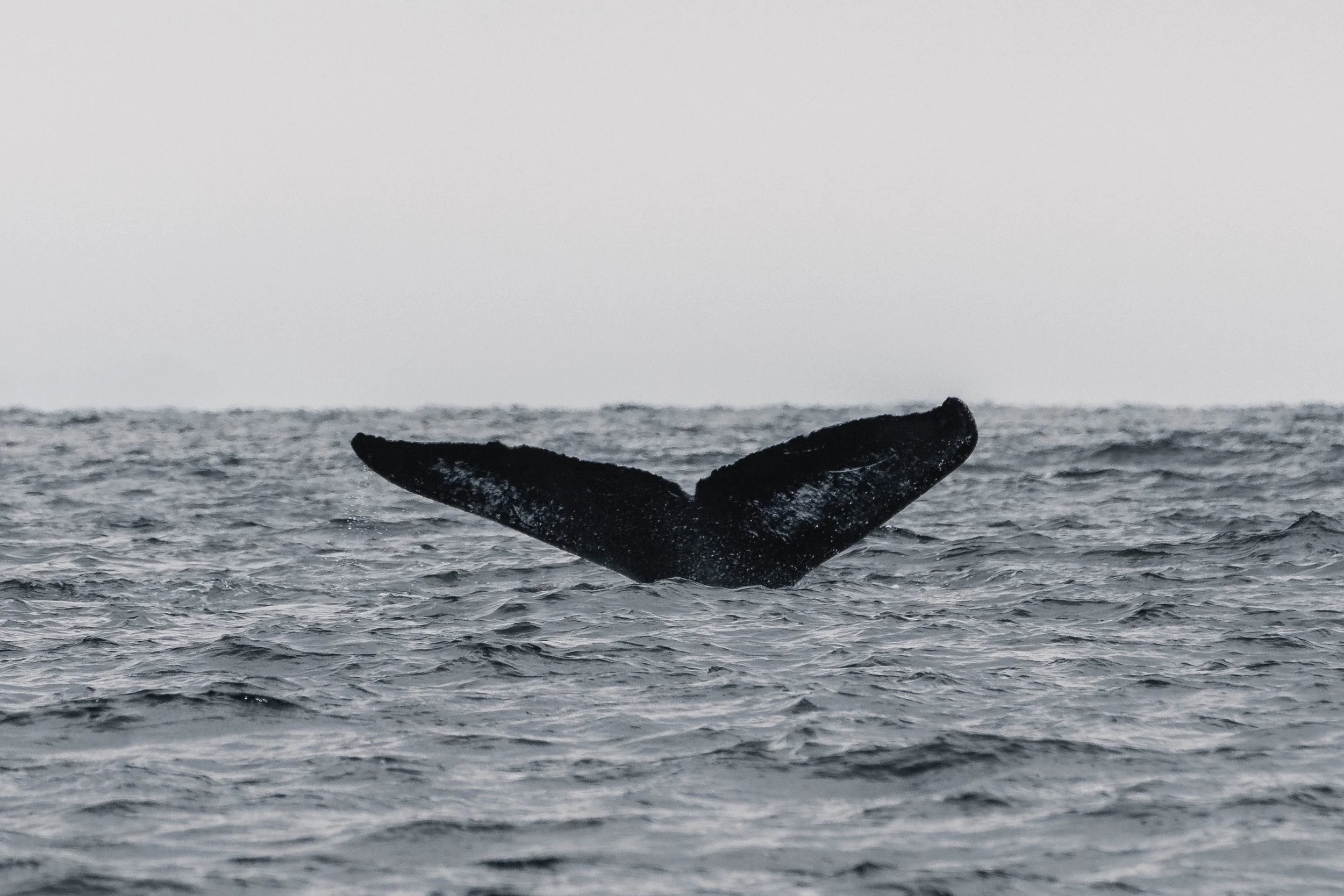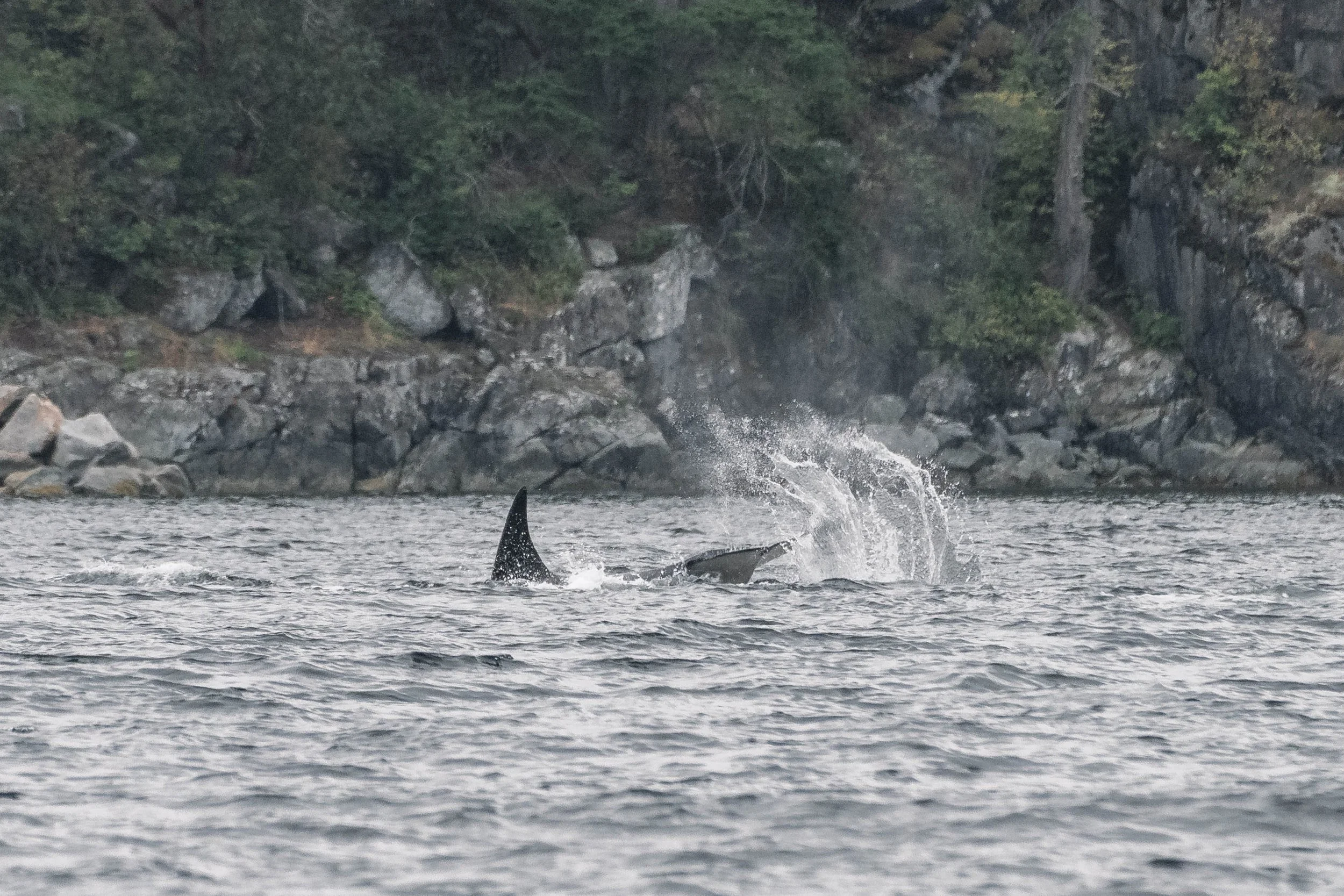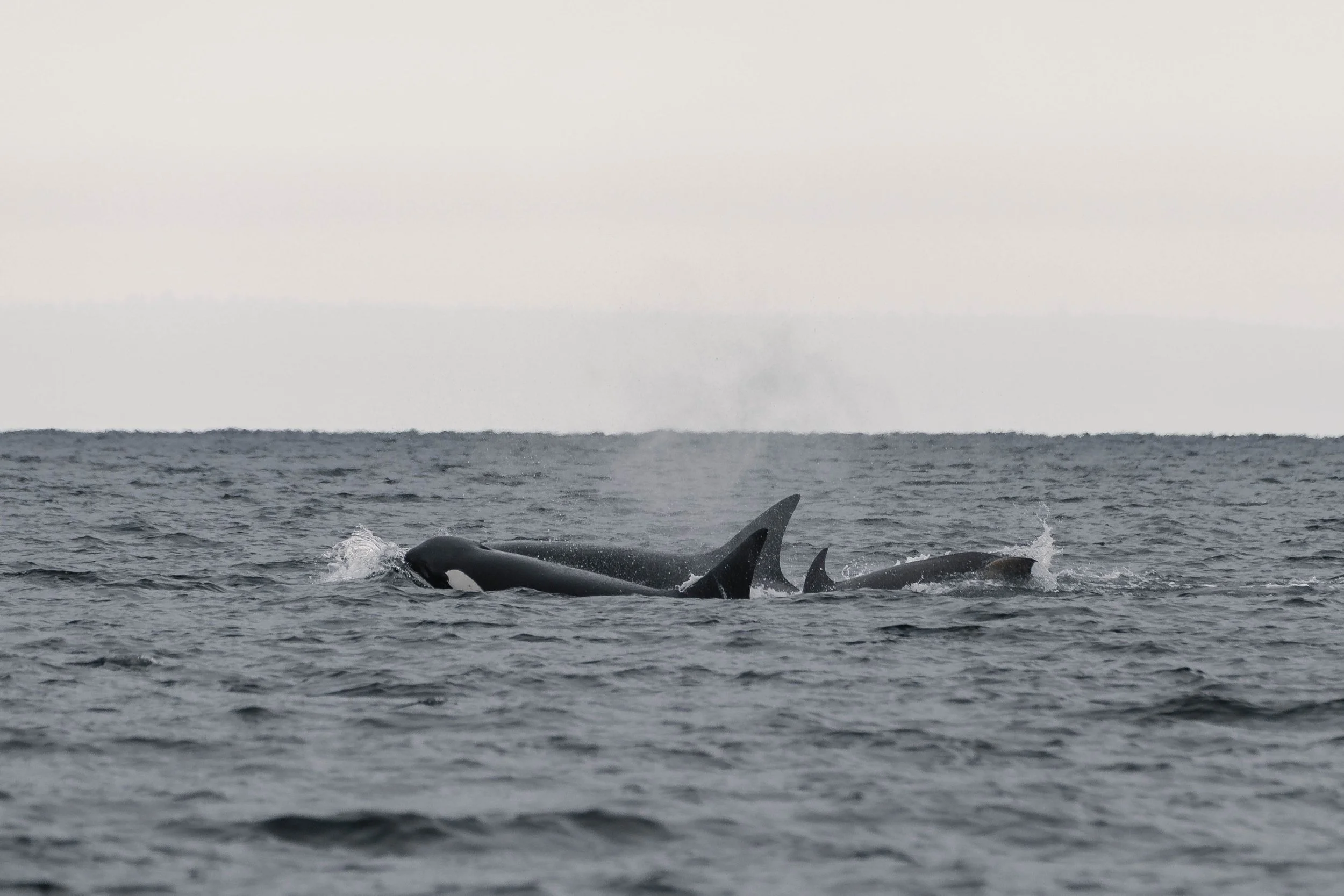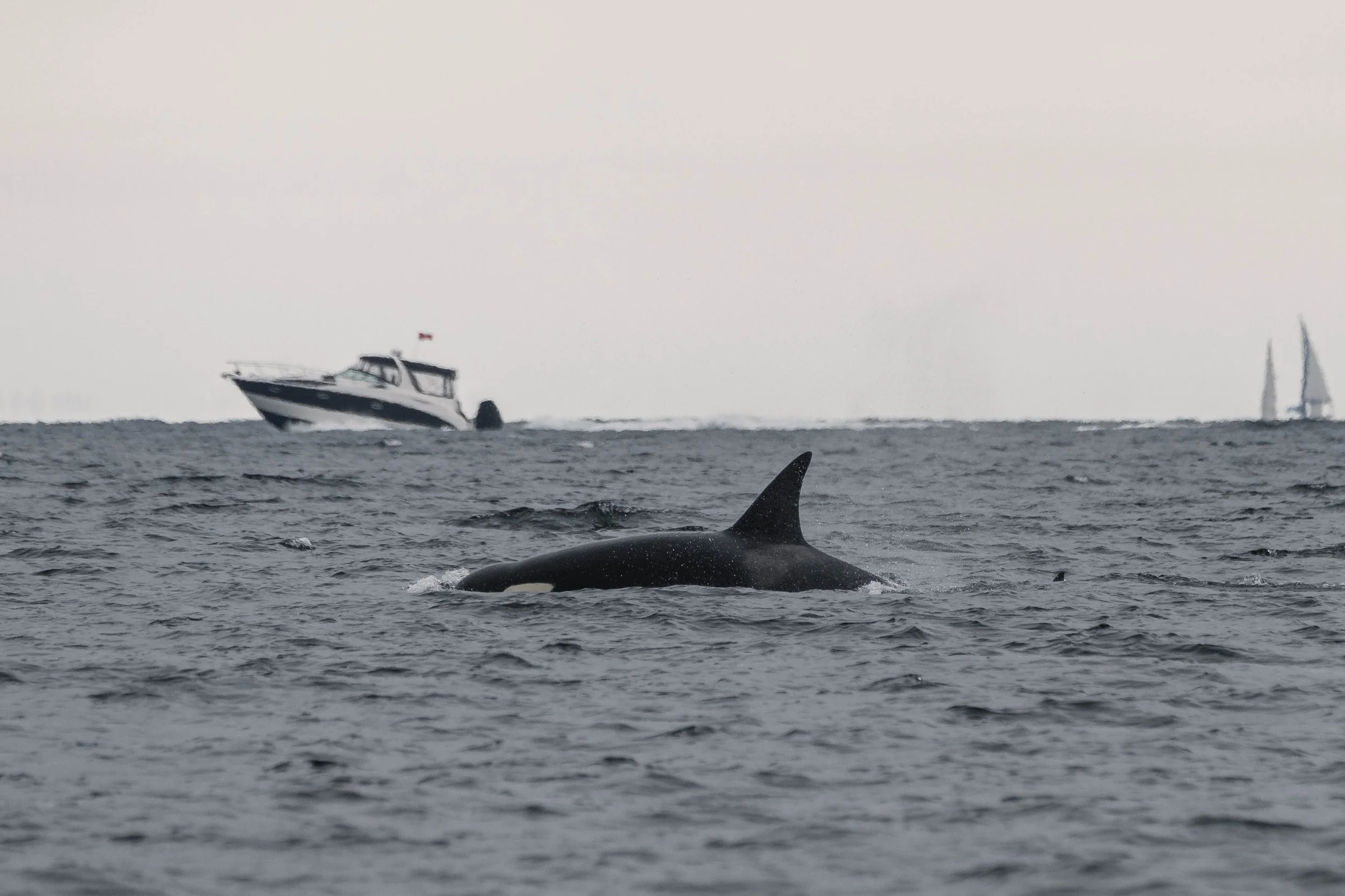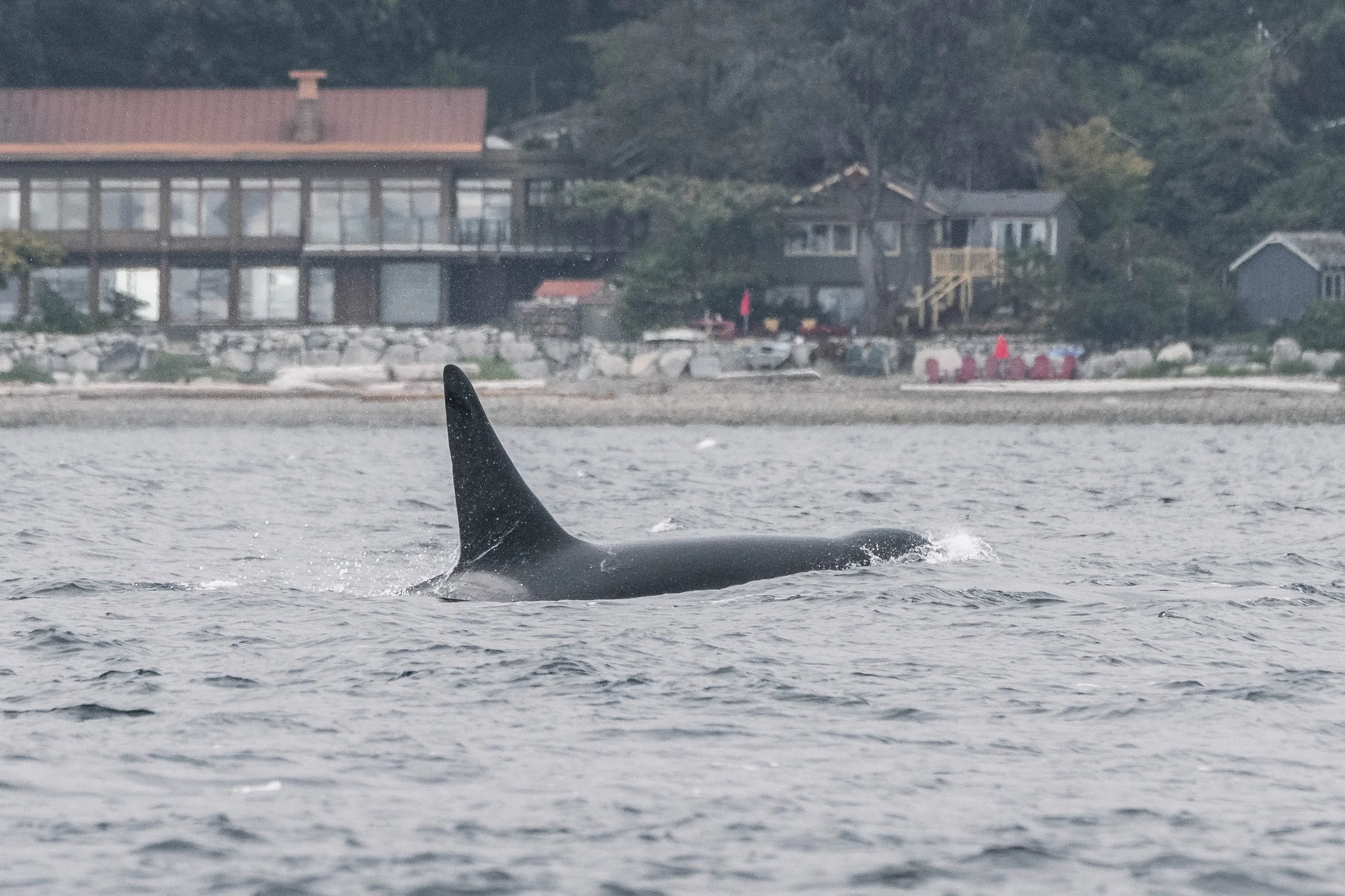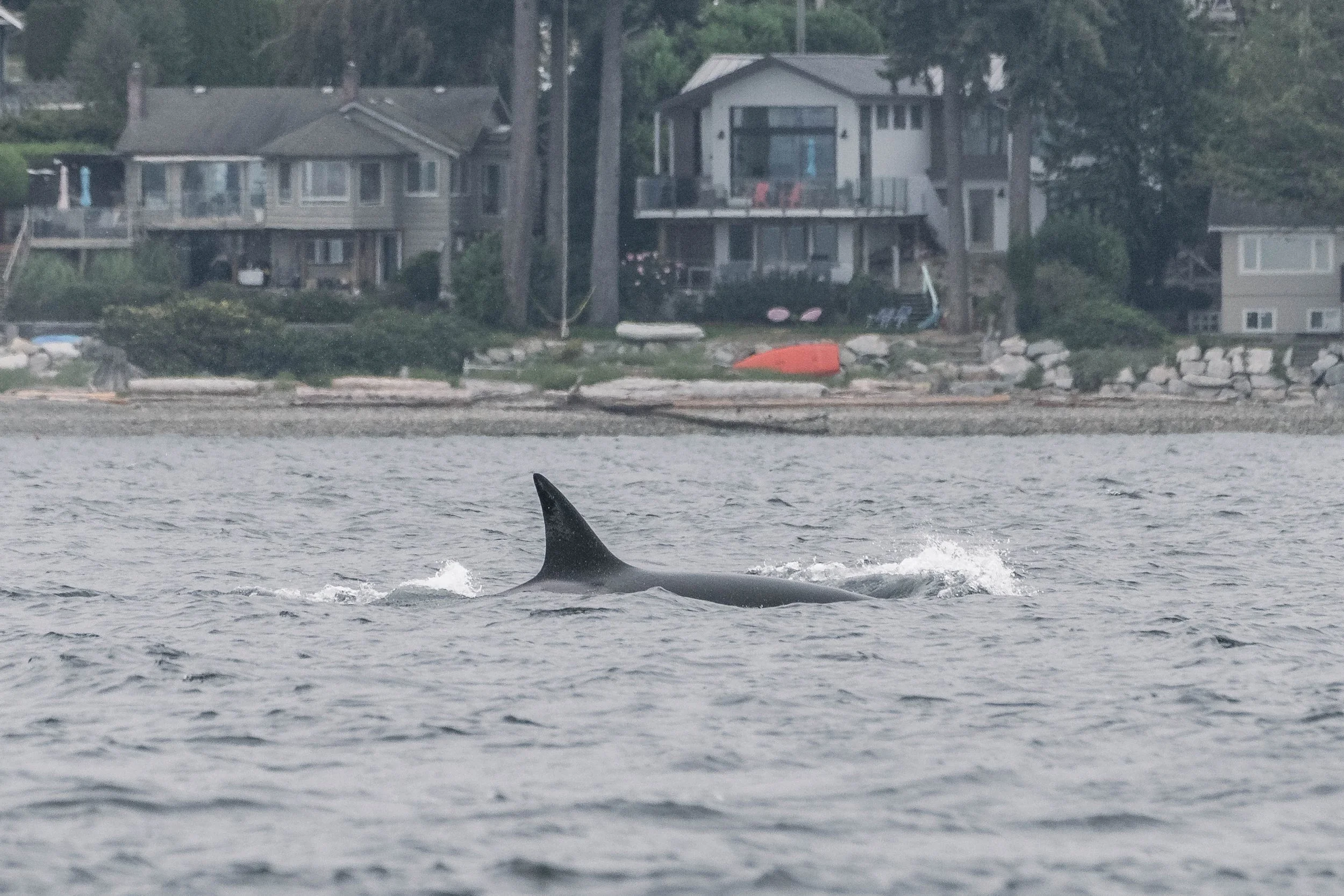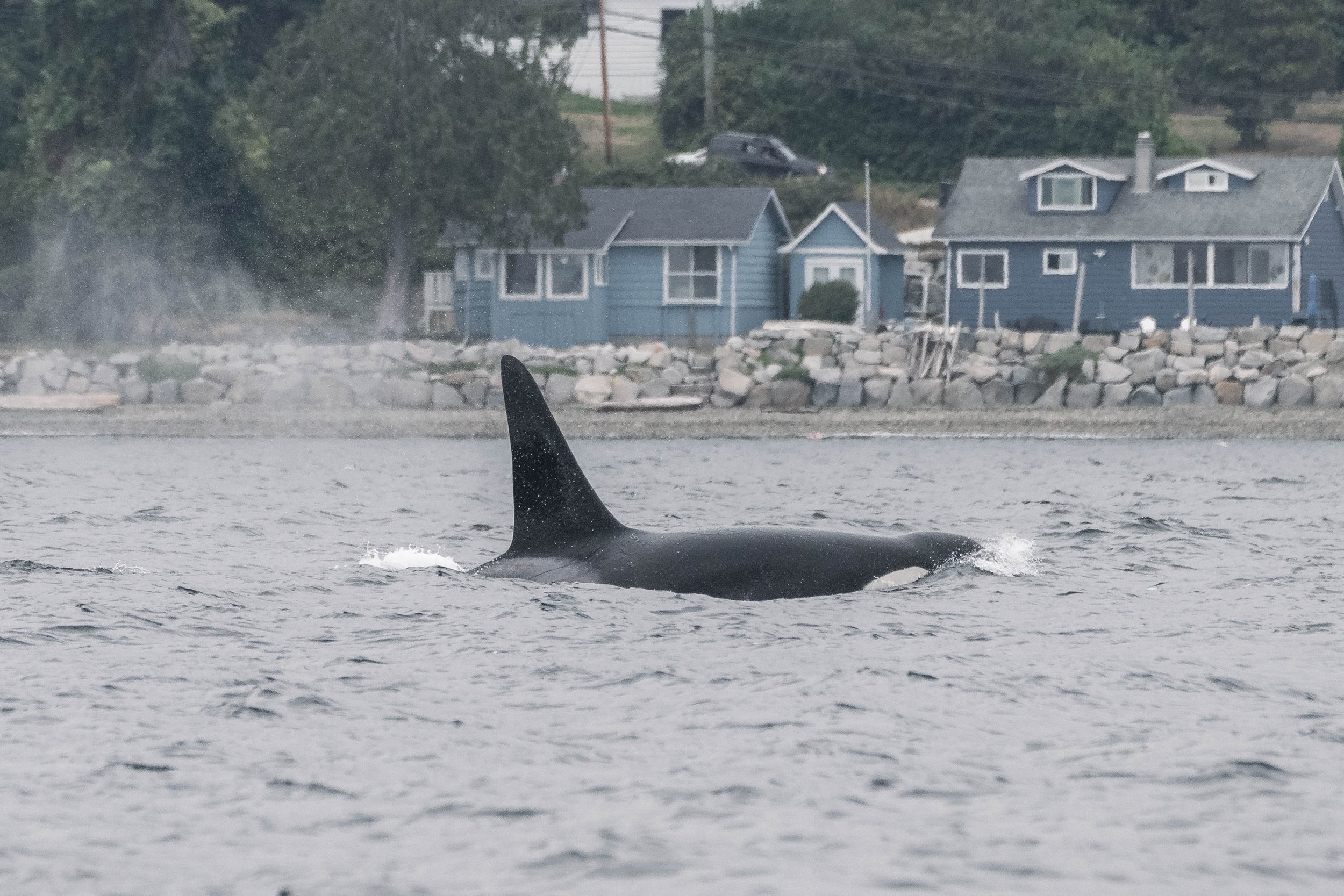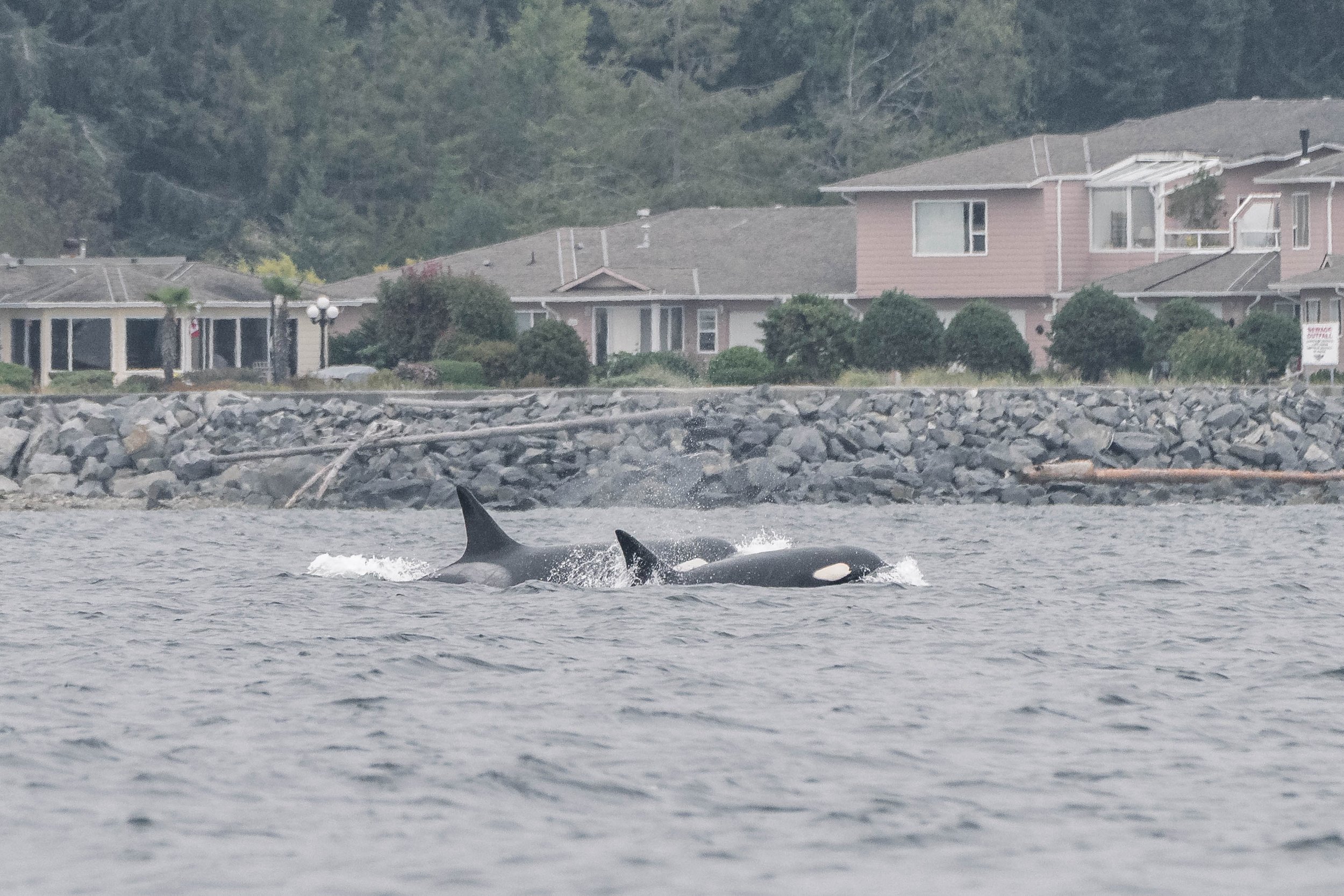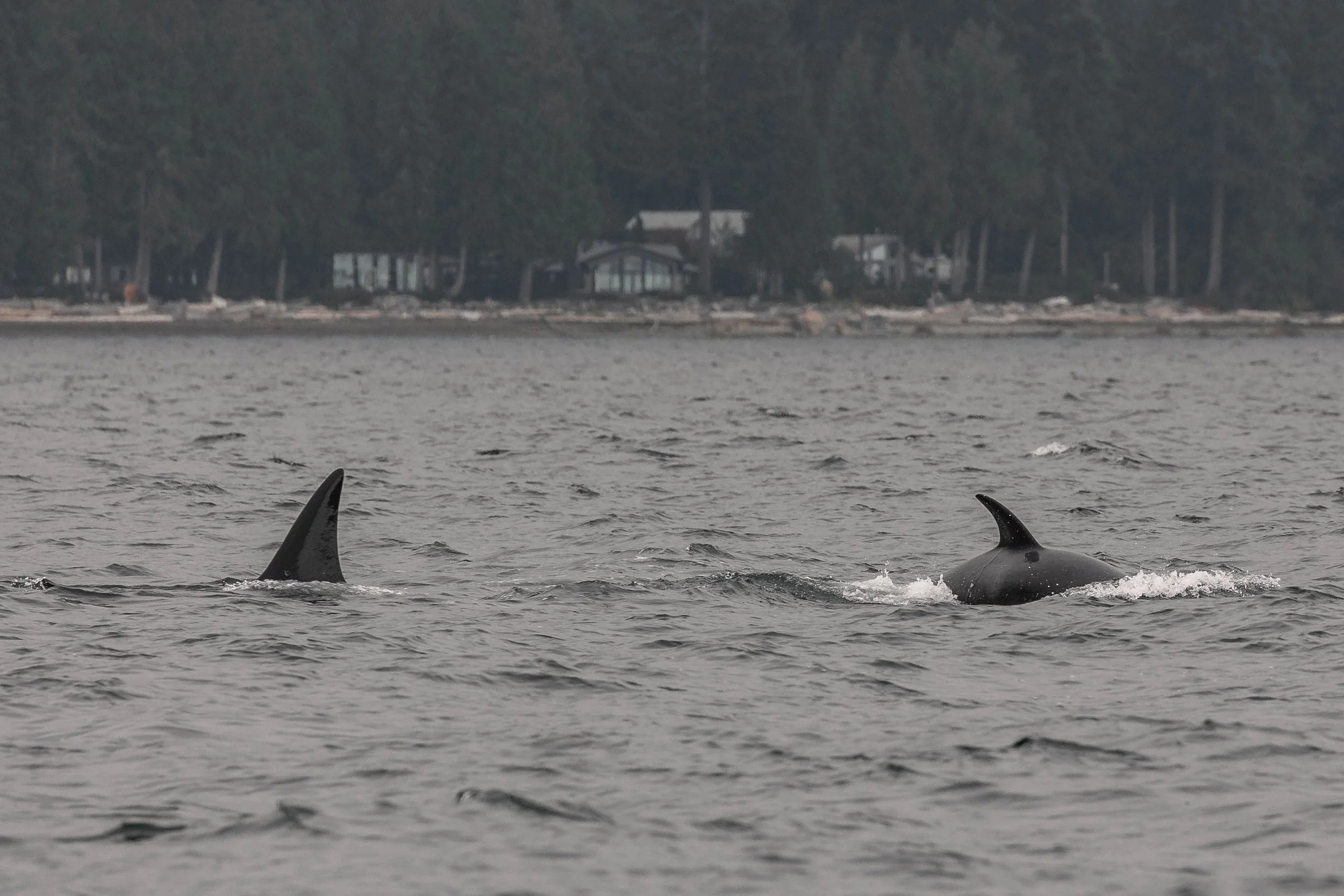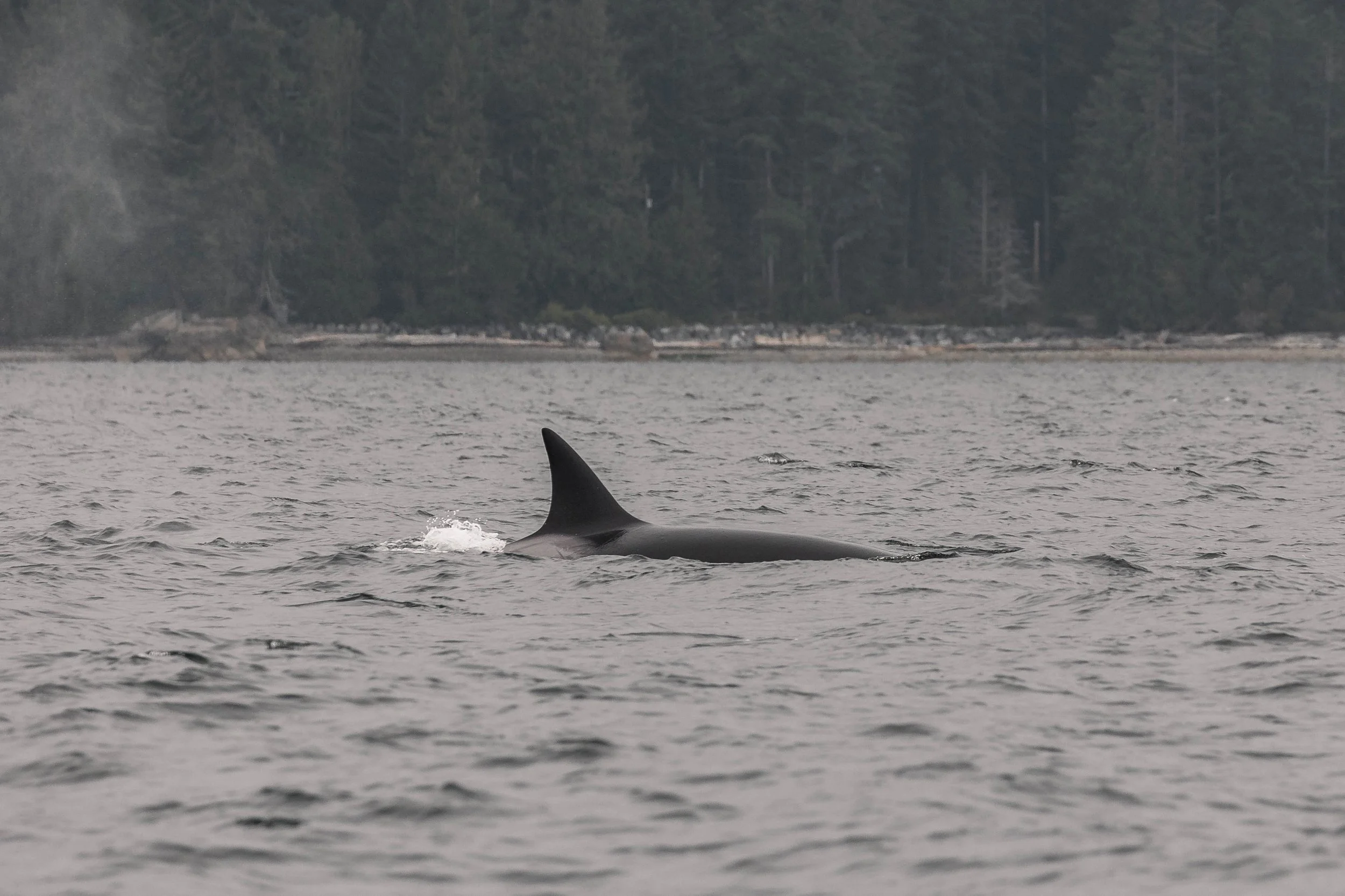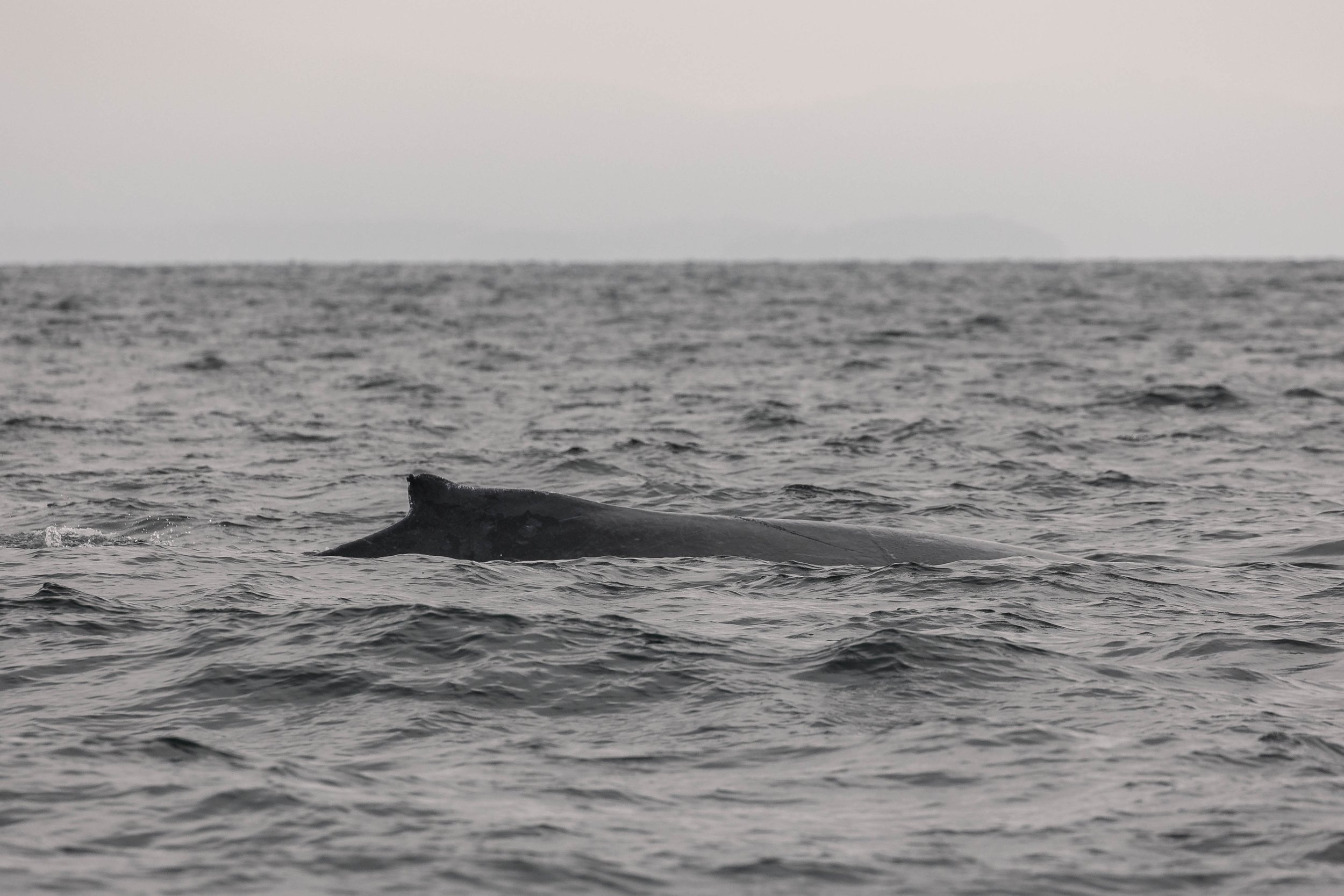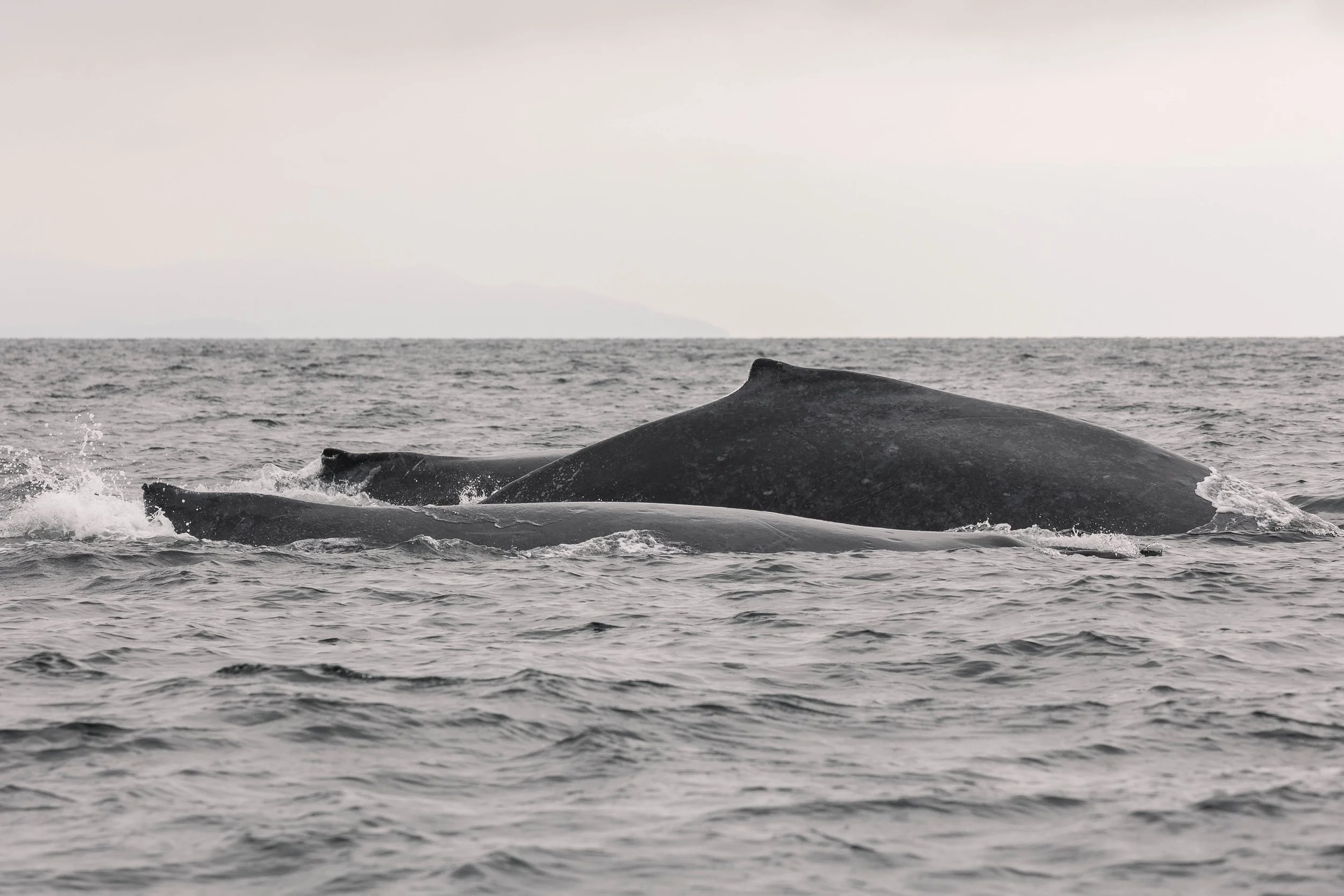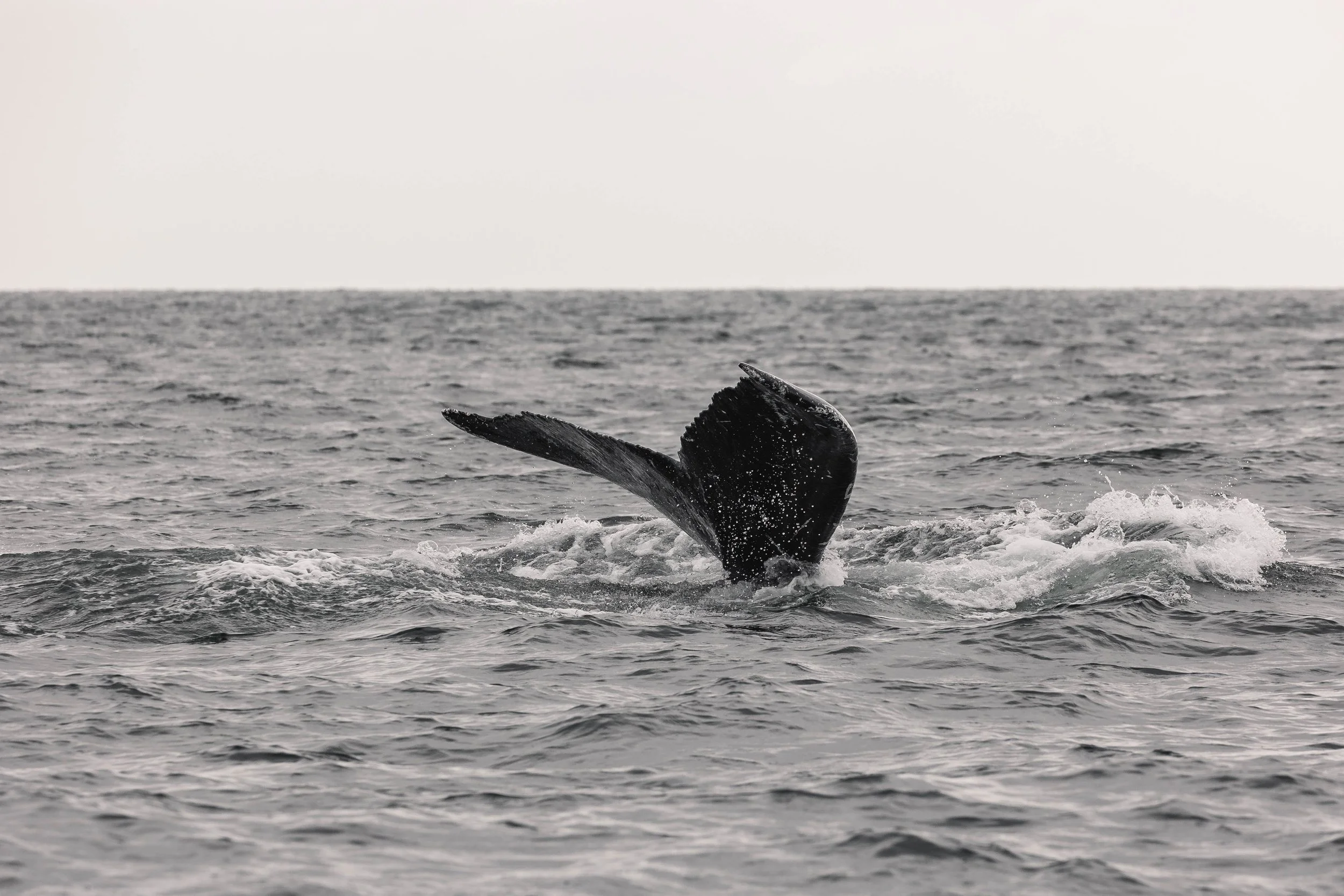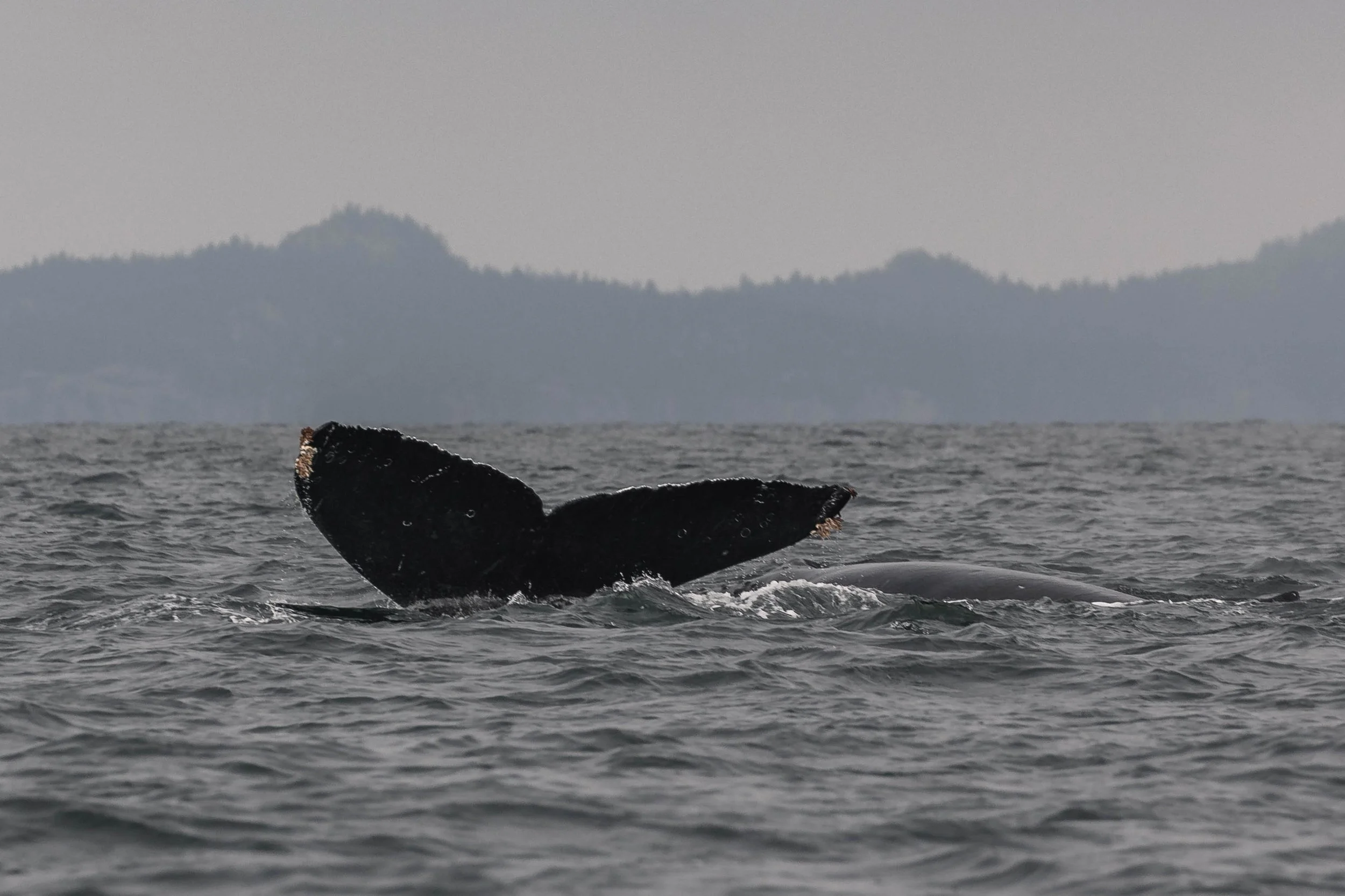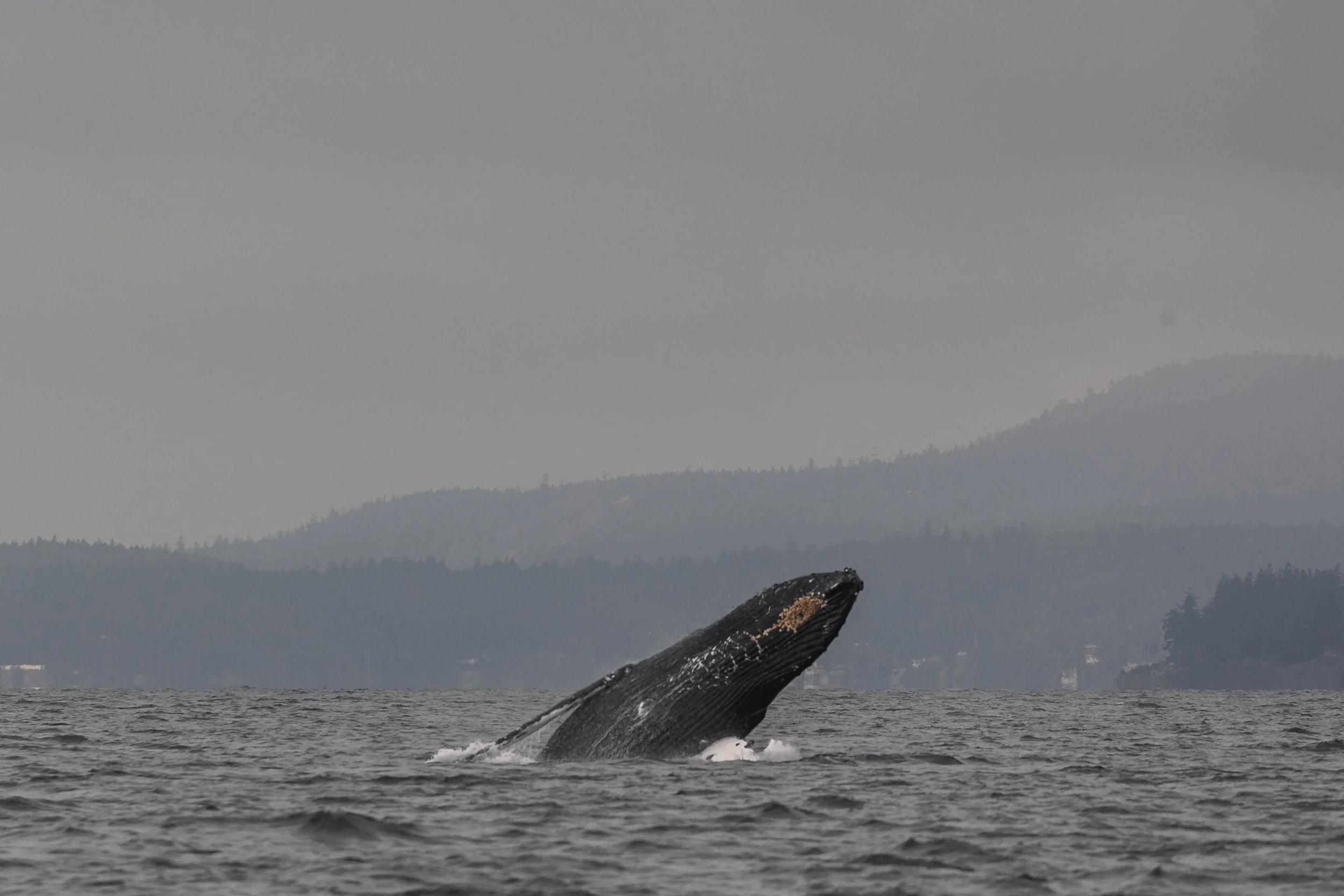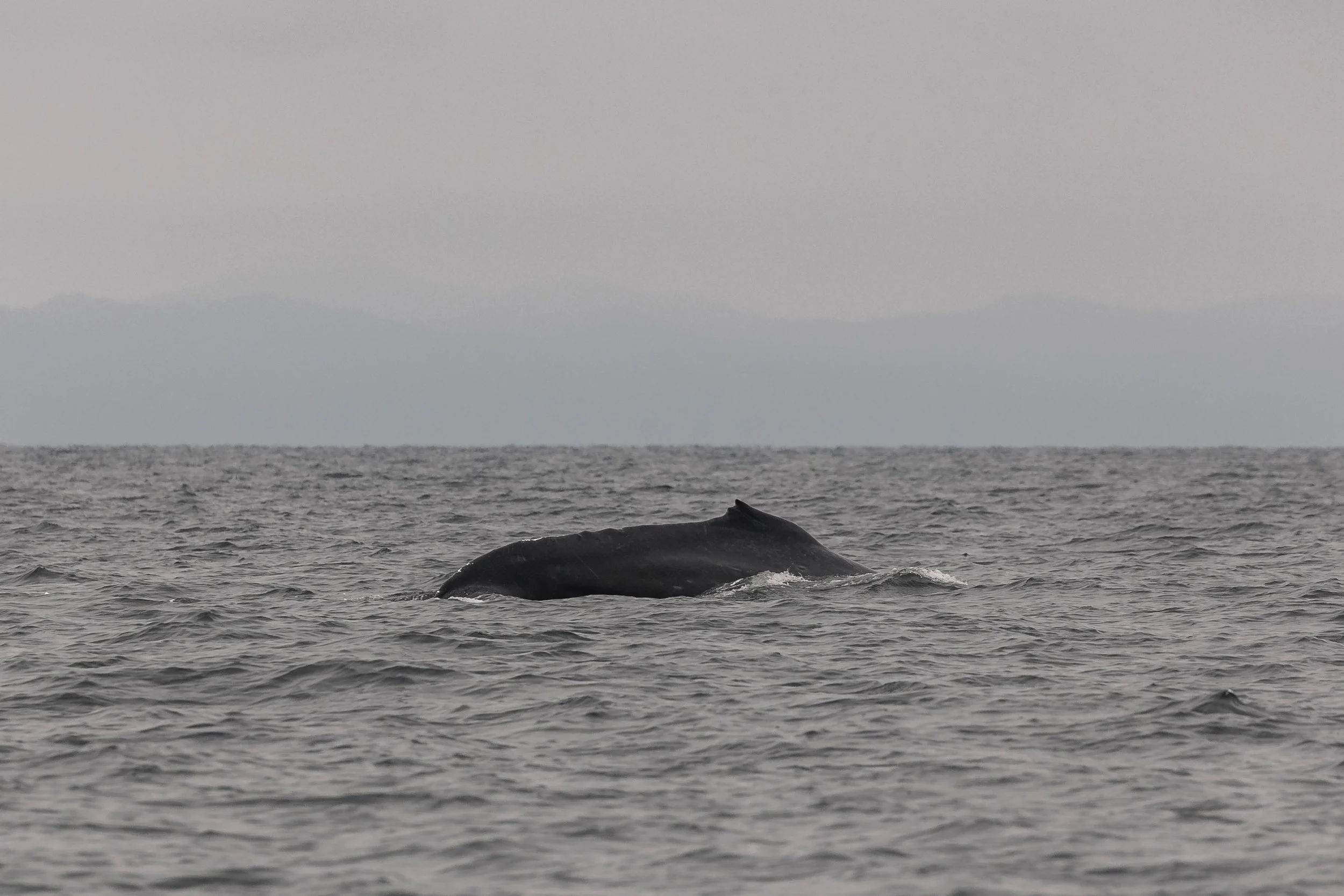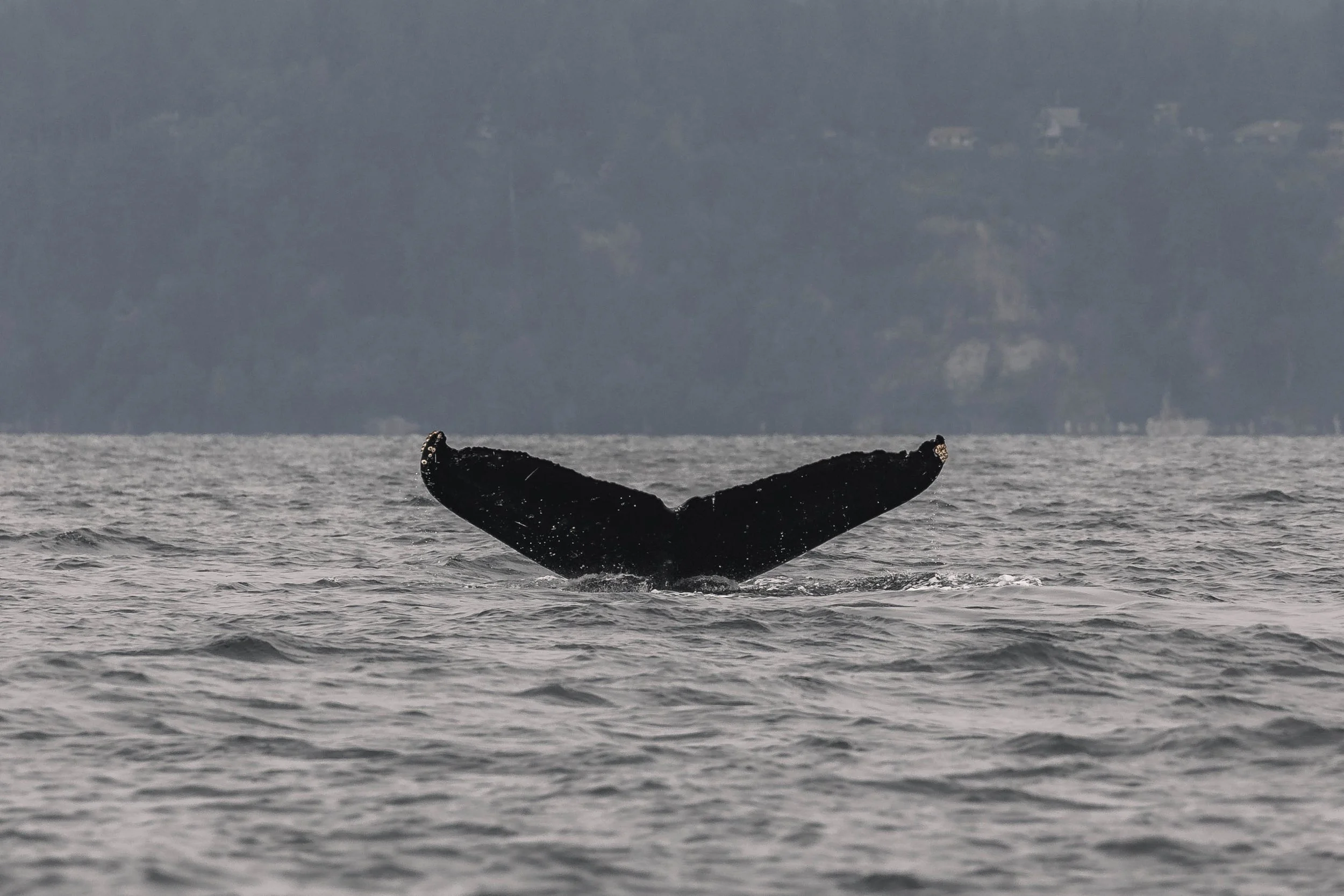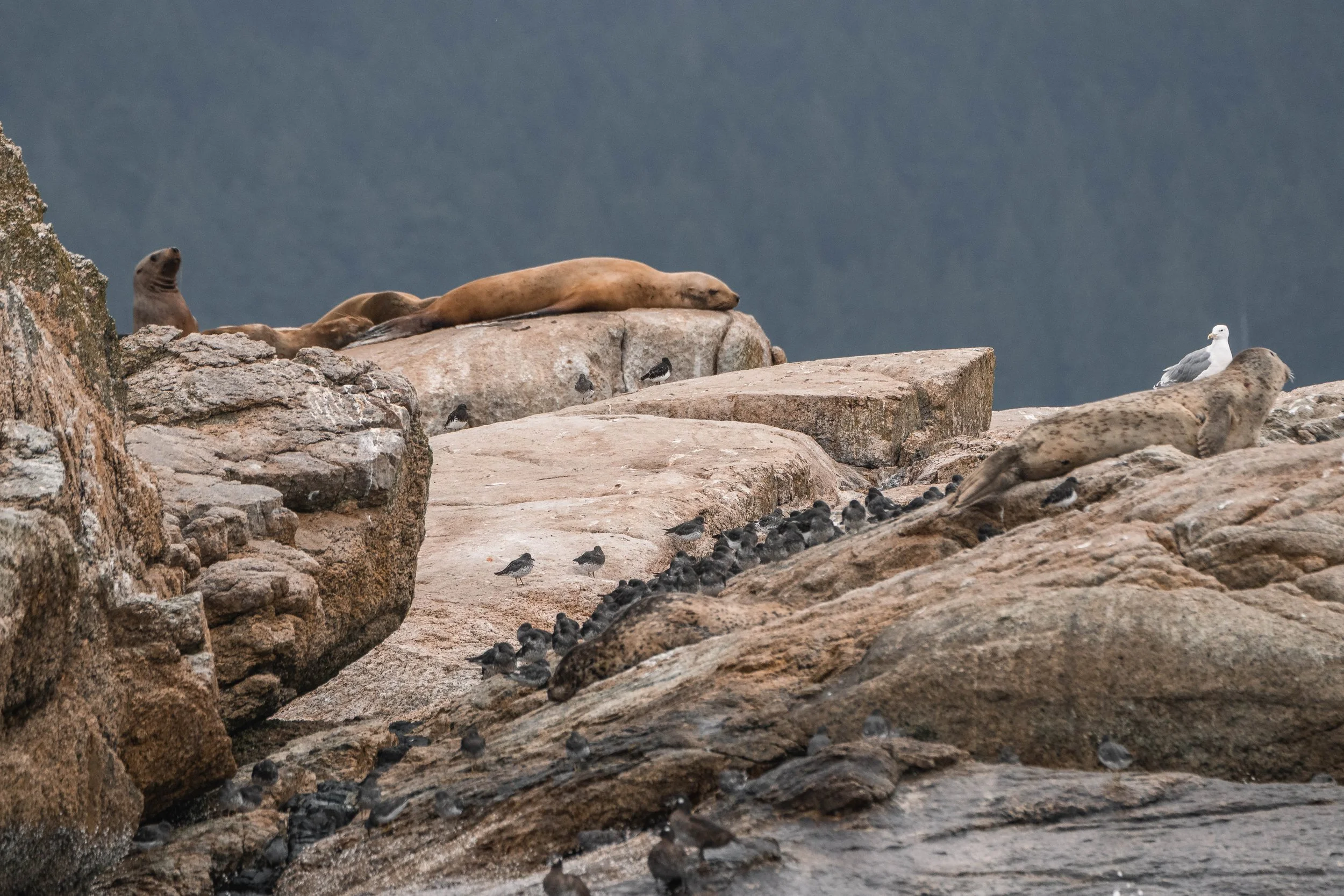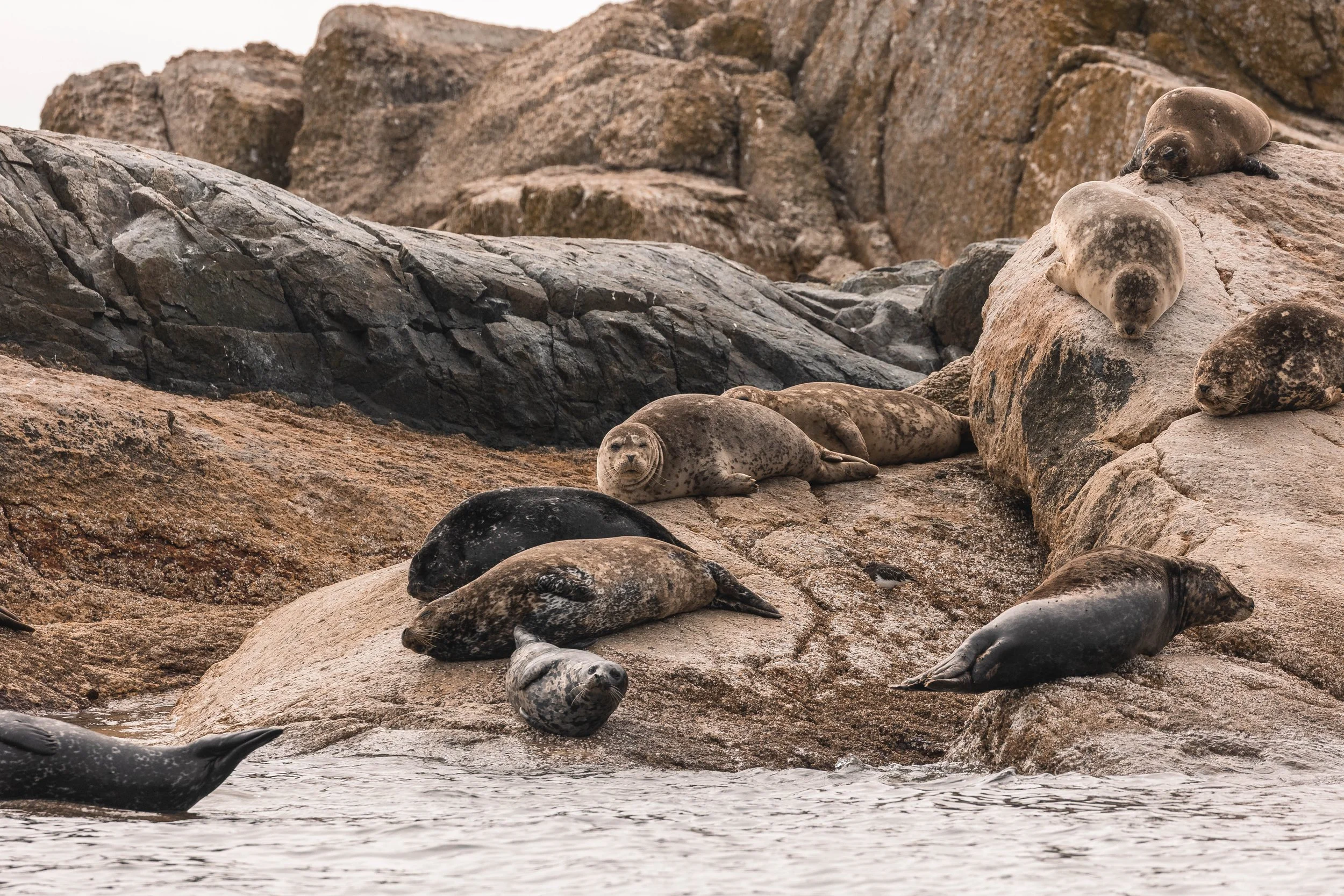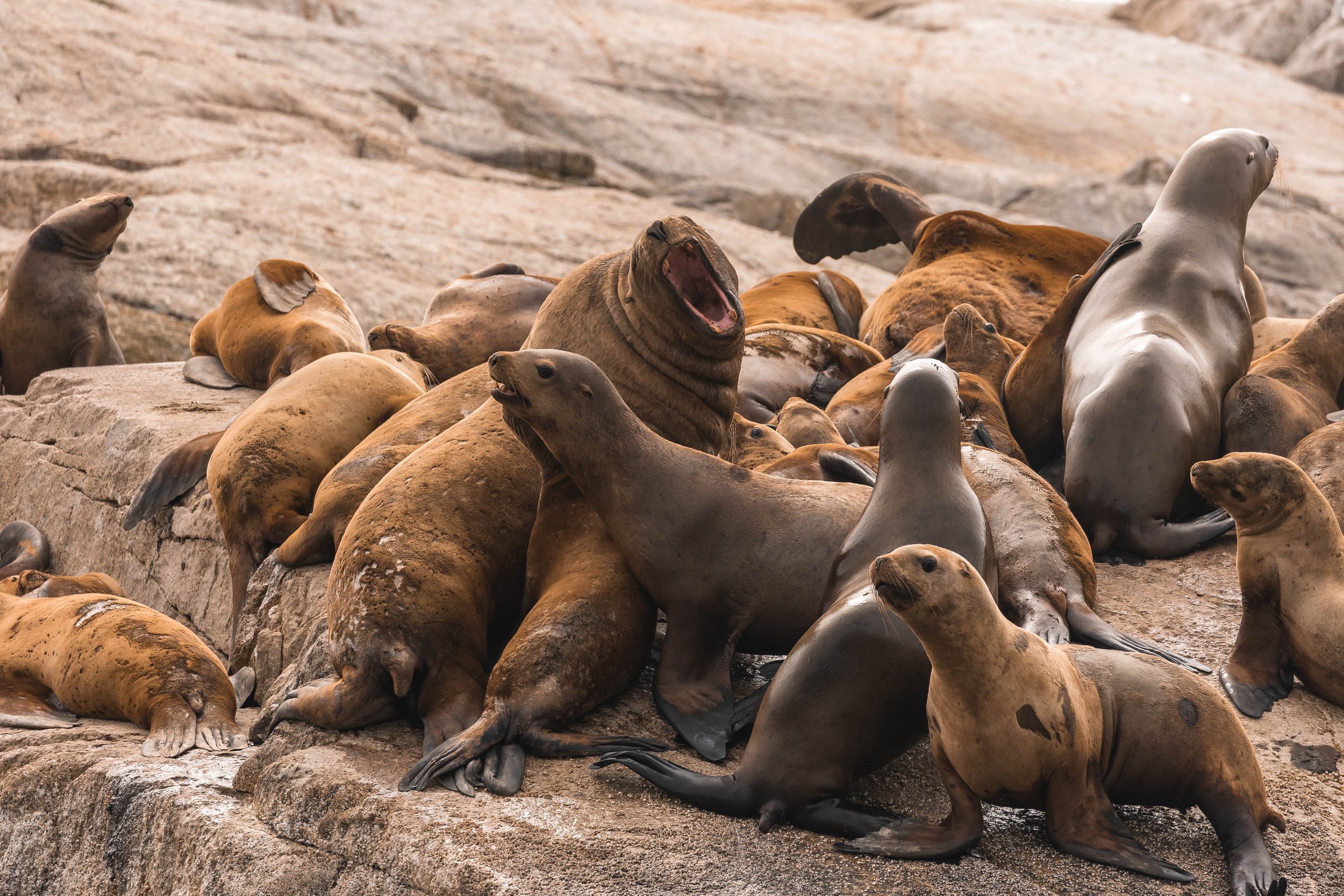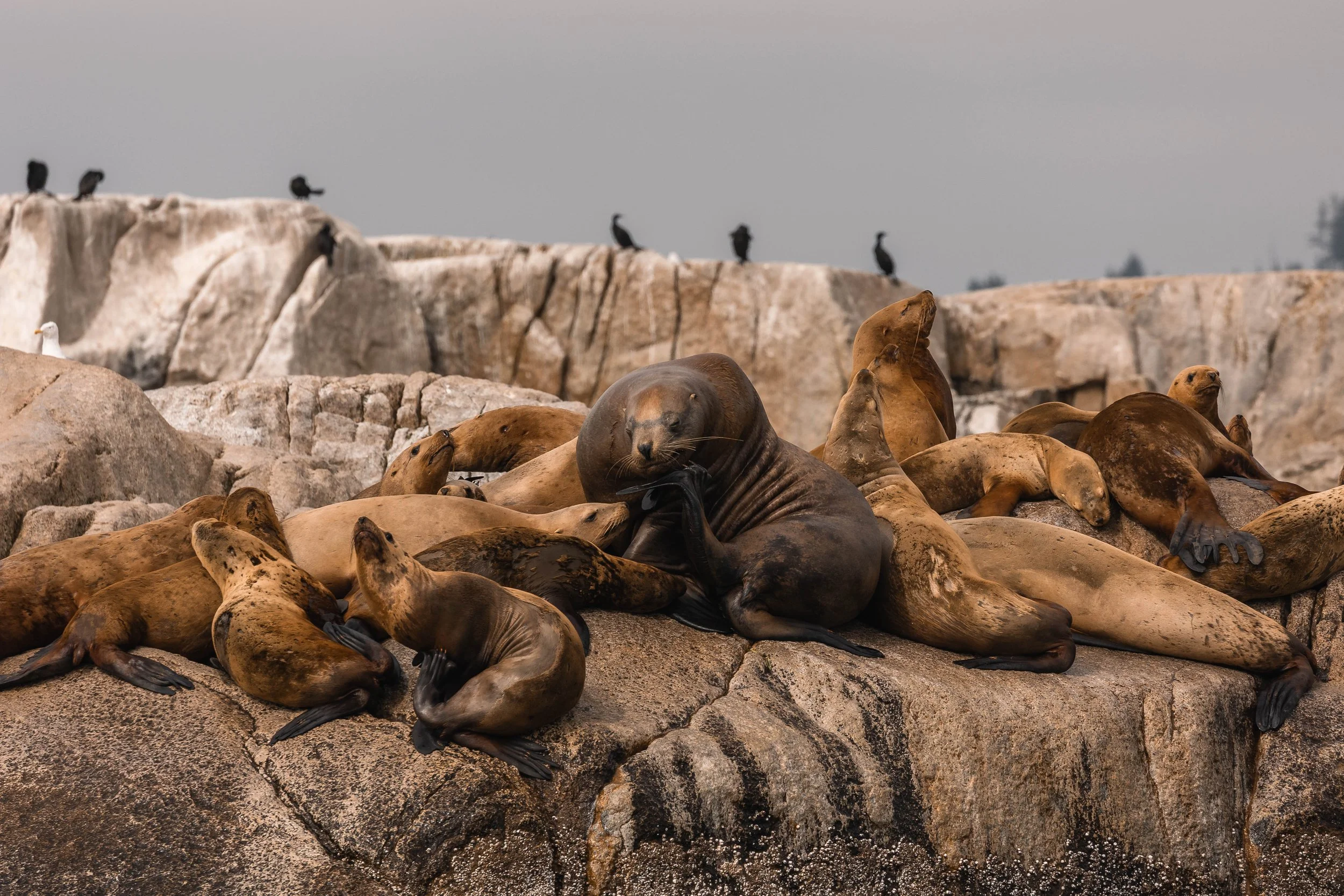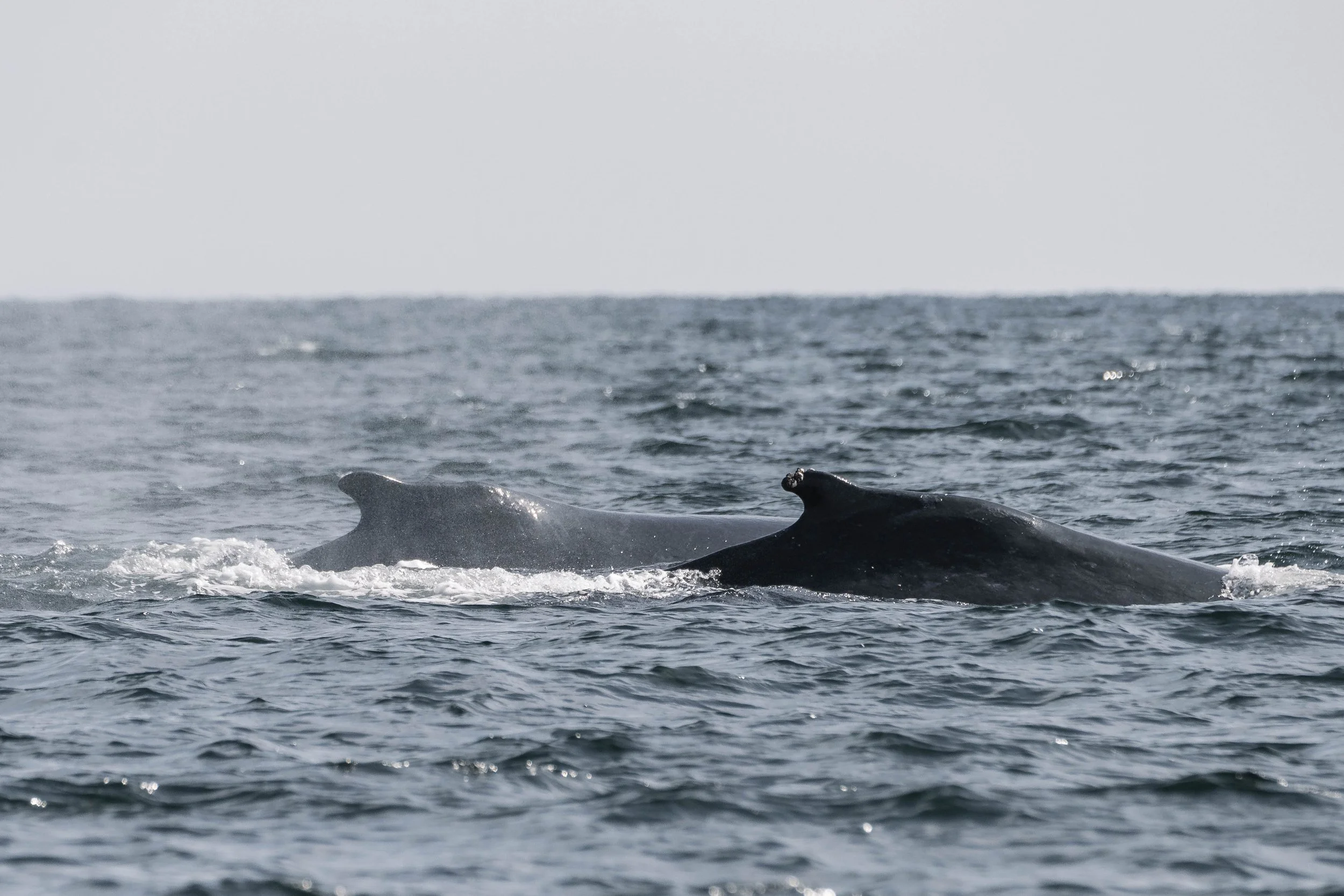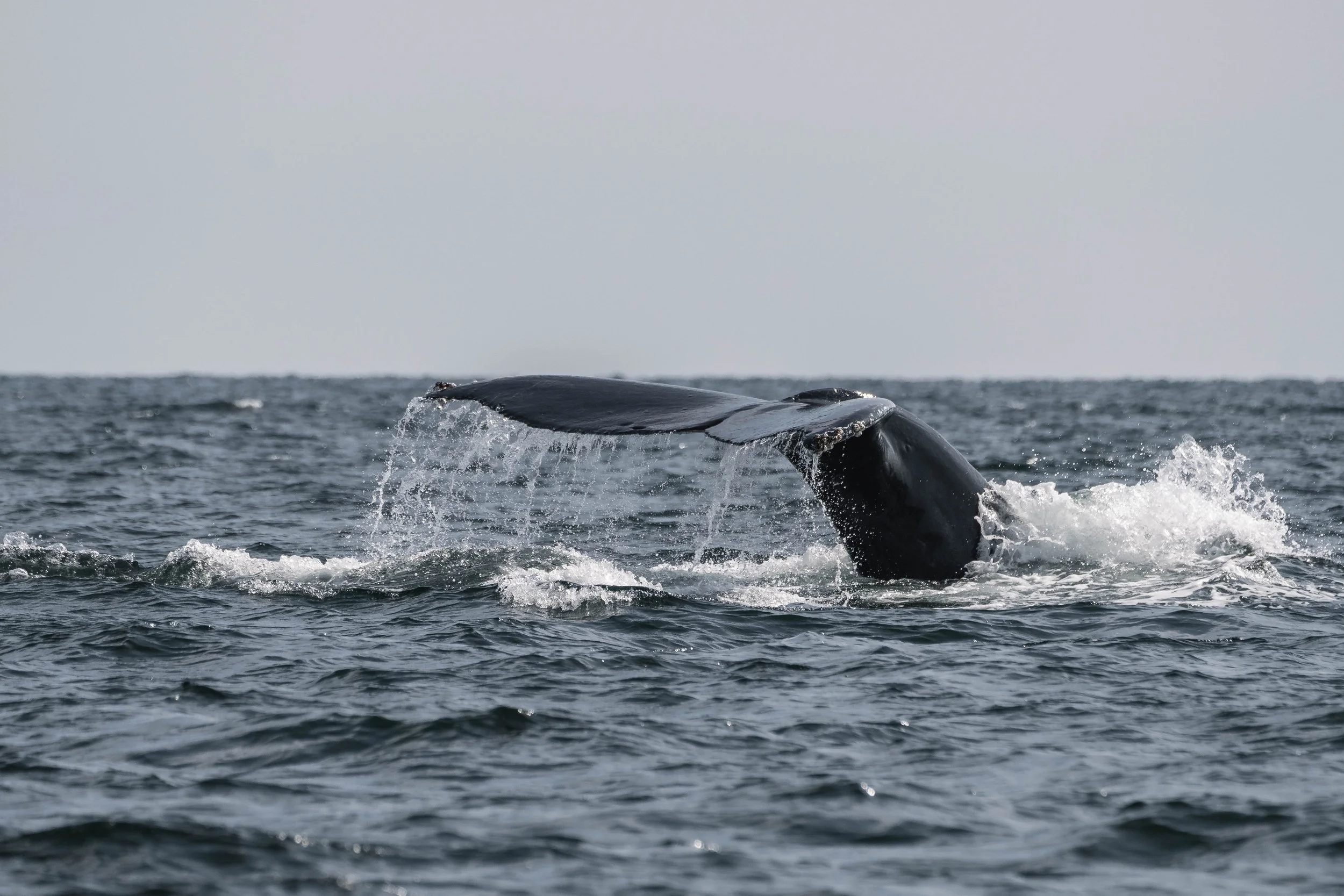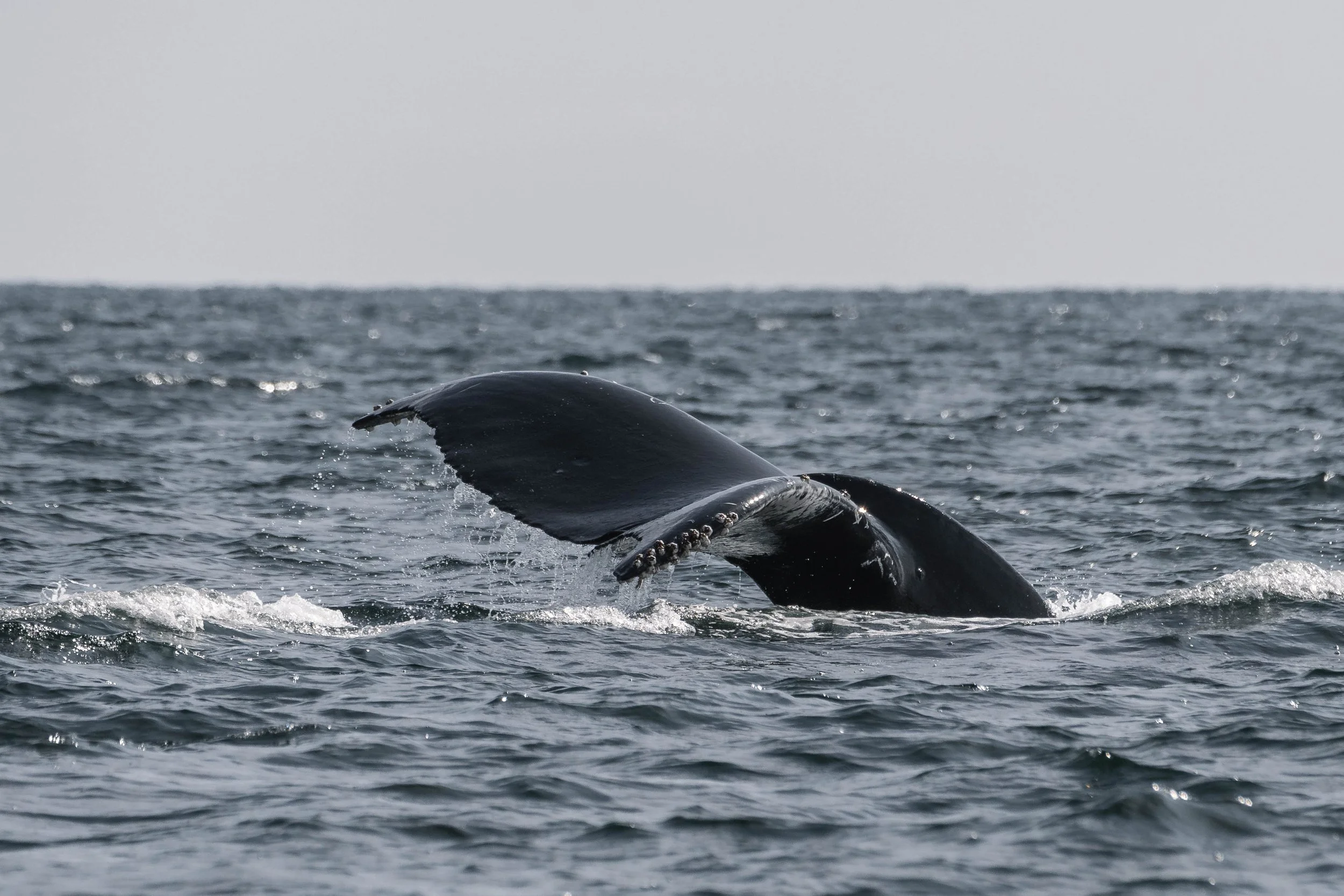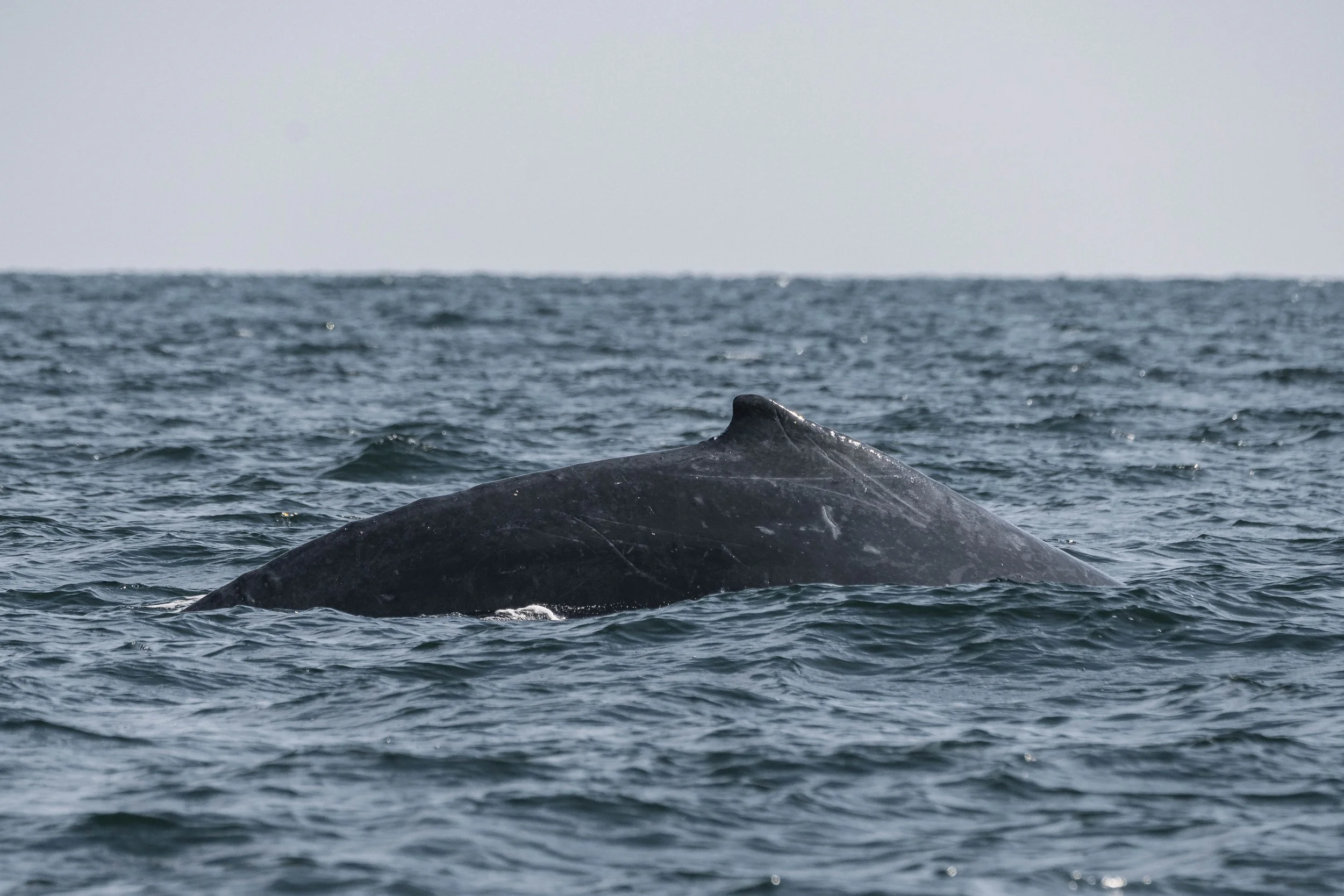September 12, 2025, 10:30 AM - A morning full of whales!
You couldn’t have asked for a more wildlife-packed day than today was for our tours. Across our three boats, we encountered three different pods of orca across two encounters, and 12 humpbacks across six encounters! It seemed that the boats couldn’t stop running into whales, and it started nearly immediately upon leaving the Harbour. All our vessels headed out into the Strait of Georgia to start our adventure, keeping our eyes peeled for either of the species of whale that we most commonly encounter on our tours: orca (Killer Whales) and humpbacks! At nearly the same time, two of our boats had encounters; one of the open boats spotted a pair of humpback whale blows, and the other two boats spotted two large black dorsal fins of an orca on the horizon.
Let’s start with these humpbacks! It turned out to be a pair of whales travelling together: Fader (BCY0195) and Stingray (BCZ0409). Stingray is a known female, since she has brought back at least one calf to our waters. She typically likes to spend her time further north, but we tend to get at least a few weeks with her. Fader, on the other hand, is thought to be male, since he is currently 25 years old and hasn’t brought a calf back before. We also have photos from past trips that show the underside of his tail without a hemispherical lobe present, although the angle is a bit difficult to confirm with 100% certainty. Interestingly, these two have been spotted travelling together before, adding to the growing evidence that humpbacks may have stronger social bonds and preferred travel partners than once believed. We didn’t stay with these two for long, as we received a report of a different pod of orcas than the ones our other boat had found, across the Strait of Georgia. So, we headed that direction to help with the search.
While one boat was watching Fader and Stingray, the other two had spotted orca! These two were quickly identified as a pair of brothers who have been spending lots of time around Nanaimo lately:
T060D Onca ♂ (2004)
&
T060E Lynx ♂ (2008)
These two were in travel mode and quite spread out while we were watching them. It is quite common to see orca spreading out, as it increases their chances of coming across food. Despite the distance, they could easily stay in touch. Orca use powerful underwater calls to communicate across kilometres, allowing them to regroup quickly and share their food when one of them makes a catch.
T101 Reef ♀ (≤1969)
T101A Rush ♂ (1993)
T101B Lagoon ♂ (1997)
T124D Field ♀ (1996)
T124D1 Salish II (2014)
T124D3 Lupine (2022)
T124D4 Dune (2024)
It was a true T-party, with lots of whales and lots of action at the surface. While we were watching these whales, we observed tail slapping, spy hops, breaching, and even some tail slapping. Whether they had just finished hunting when we arrived or were socializing, it was hard to tell, but we enjoyed our time with them nonetheless.
On the journey to and from the orca, our crews kept encountering humpbacks:
Octo (BCX1920) with an unknown companion. Octo wasn’t showing their tail, but distinctive dorsal fin scars confirmed the ID later in the office.
A trio: Europa (BCX0854), her 2025 calf, and Dandelion (BCY1107). Calves rarely lift their tails in the first year due to underdeveloped muscles, but Europa gave us a perfect fluke for identification. Later in the day, another boat even spotted Callisto, Europa’s 2021 calf, a wonderful reminder of the strong site fidelity shown by humpbacks.
Camelus (BCX2132) stole the spotlight with some surface activity, including a breach! Although it had settled down by the time our crew arrived, it was still an impressive sight.
Another vessel encountered a pair feeding together: Mow (KEY0063) and Holey Moley (BCY1220). They dove in unison, reappearing every few minutes to breathe.
The final pair of the morning was Callisto (BCX2486) with KEY0058, confirmed later using photos back in the office.
To round out the day, each boat also stopped at the White Islets. Guests were treated to the sights (and sounds!) of Steller sea lions, harbour seals, and a variety of seabirds resting on the rocky shores.
It was an incredible day on the water — the kind where you truly never know what’s around the next corner. Huge thanks to our onboard Marine Naturalists, Val Watson, Vanessa Vereschahen, and Hayleigh Hilbert, for capturing the photos that tell the story of today’s adventures.
Fader & Stingray
The beautiful white underside of Stingray’s tail. Photo by Val Watson.
The unique underside of Fader’s tail. Photo by Val Watson.
Onca & Lynx
T060D Onca surfacing in the waves. Photo by Vanessa Vereschahen.
T101s & T214Ds
T124D Field surfacing by the shore. Photo by Val Watson.
T101 Reef surfacing next to T124D Field. Photo by Val Watson.
T101 Reef splashing with her tail. Photo by Val Watson.
T101 Reef, T124D Field, and T124D4 Dune splashing behind them. Photo by Val Watson.
T124D1 Salish II surfacing in the waves. Photo by Val Watson.
T124D3 Lupine breaching while travelling beside the two matriarchs. Photo by Val Watson.
T101B Lagoon breaking through a wave. Photo by Val Watson.
A great look at T124D Field. Photo by Val Watson.
T101A Rush. Photo by Val Watson.
The T101 Brothers surfacing together, with T101A Rush in the front and T101B Lagoon in the back. Photo by Val Watson.
T101 Reef surfacing just behind T124D1 Salish II. Photo by Val Watson.
T101A Rush swimming along the Sunshine Coast. Photo by Vanessa Vereschahen.
T124D4 Dune surfacing beside T101B Lagoon. Photo by Vanessa Vereschahen.
T124D Field surfacing. Photo by Hayleigh Hilbert.
T124D Field on the left with her calf, T124D4 Dune on the right. Photo by Hayleigh Hilbert.
A great look at T124D Field as she surfaces, showing off her saddle patch. Photo by Hayleigh Hilbert.
T124D Field with her head poking out of the waves. Photo by Hayleigh Hilbert.
T101B Lagoon showing off his eye patch. Photo by Hayleigh Hilbert.
A fun family photo with the two boys, T101 B Lagoon (front) and T101A Rush (back) surfacing one direction with their mom T101 Reef going the opposite way in the middle. Photo by Hayleigh Hilbert.
T124D4 Dune showing off their eye patch! Photo by Hayleigh Hilbert.
T101A Rush swimming towards the camera. Photo by Hayleigh Hilbert.
Octo & Friend
Octo’s very scarred up dorsal fin. Photo by Vanessa Vereschahen.
Octo surfacing on the left, with the unknown friend on the right. Photo by Vanessa Vereschahen.
Octo diving on the left with the unknown jsut ahead. Photo by Vanessa Vereschahen.
Dandelion, Europa, & calf
Dandelions very unique dorsal fin. Photo by Hayleigh Hilbert.
Danelion (front), Europa (middle) and Europa’s 2025 calf (back) surfacing together. Photo by Hayleigh Hilbert.
Dandelion going for a dive. Photo by Hayleigh Hilbert.
Europa arching her back to dive. Photo by Hayleigh Hilbert.
The underside of Europa’s tail as she dives beside her calf. Photo by Hayleigh Hilbert.
Camelus
Camelus breaching. Photo by Hayleigh Hilbert.
Camelus swishing teir tail at the surface. Photo by Hayleigh Hilbert.
Camelus flikcing their tail. Photo by Hayleigh Hilbert.
The underside of Camelus’ tail. Photo by Hayleigh Hilbert.
The White Islets
Can you spot all the species in this photo? We see 6: Stellers Sea Lions, Harbour Seals, Surf Birds, Black Turnstones, Harlequin ducks, and a gull! Photo by Val Watson.
A gull got itself some seaweed. Photo by Vanessa Vereschahen.
A pile of Steller Sea Lions on the White Islets. Photo by Vanessa Vereschahen.
Some cozy looking Harbour Seal on the rocks of White Islets. Photo by Hayleigh Hilbert.
Did you know that when an animal put their whiskers forward like this, its called “whisking”? Photo by Hayleigh Hilbert.
Fighting amongst the Steller Sea Lions. Photo by Hayleigh Hilbert.
An Itchy Steller Sea Lion. Photo by Hayleigh Hilbert.
Mow & Holey Moley
Holey Moley going for a dive. Photo by Val Watson.
A fluke waterfall from Mow. Photo by Val Watson.
Mow in the front with Holey Moley surfacing behind. Photo by Val Watson.
A lovely fluke waterfall from Holey Moley.Photo by Val Watson.
Mow diving. Photo by Val Watson.
KEY0058 & Callisto
Callisto’s dorsal fin. Photo by Val Watson.
Callisto going for a dive. Photo by Val Watson.
KEY0058 going for a dive. Photo by Val Watson.


